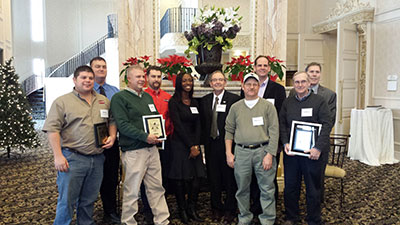
Features
Education
Event Reports
Finding the Right RAP Mix
OHMPA’s fall asphalt seminar focuses on best practices for recycled materials.
February 12, 2014 By Andrew Macklin
Test tracks in Ontario and Alabama are helping to discover the best
asphalt mixes for today’s roads that include the use of recycled
aggregates.
Test tracks in Ontario and Alabama are helping to discover the best asphalt mixes for today’s roads that include the use of recycled aggregates.
 |
|
| The OHMPA Trillium Awards recognize the best of the best in the production of asphalt in Ontario.
|
At the 2013 Ontario Hot Mix Producers’ Association’s Fall Asphalt Seminar, representatives from both the Centre for Pavement and Transportation Technology (CPATT) and the National Center for Asphalt Technology (NCAT) presented information about the research being done to discover how best to use RAP in roadbuilding to close to 500 people in attendance.
At the National Center for Asphalt Technology, located at Auburn University in Auburn, Ala., research is being done to understand the best materials mix involving RAP. Established in 2000, the NCAT Test Track contains 46 test sections of 200 feet each, 26 straight and 20 curved stretches. The track contains two types of test sections, surface layer performance and full-depth structural studies, and the research at the track is done in three-year cycles.
The focus of the discussion at OHMPA, led by NCAT lead researcher Dr. Richard Willis, centred on a test started in 2006 at the track. Six sections of track were used for the study, two containing 20 per cent RAP and four containing 45 per cent, using different binders in each section. The purpose was to figure how the 20 and 45 per cent RAP mixes would hold up in strenuous testing, and which binder worked best with the recycled materials.
The test results showed that the 45 per cent RAP mixes could stand up to rigorous use, providing durability and strong rutting performance. The softest binder used in the test on the 45 per cent section, the 52-28, did provide significantly better results, causing Dr. Willis to conclude that the use of the 52-28 was the most cost-effective long term.
With greater acceptance of RAP materials in both Canadian and American roadbuilding, understanding best practices for materials mixes is important for contractors. “It’s about optimizing our pavement design,” says Dr. Willis. “It’s about learning to put the right materials in the right place in the road build.”
In Waterloo, Ont., CPATT is working on similar tests involving the use of RAP. Dr. Susan Tighe focused on a current round of tests being done in co-operation with the Asphalt Institute based in Lexington, Ky. The five-year test, running from 2010 to 2014, involves determining the best quantity of recycled asphalt pavement to be used in hot mix asphalt. The tests involve using aggregate from both northern Ontario and southern Ontario, to determine if any qualitative differences exist, and are tested with mixes of zero, 15, 20, 30 and 40 per cent RAP with different binder combinations. Tighe said that CPATT has some preliminary data so far, but that the full extent of the tests will be determined next year.
Recognizing the best
OHMPA also celebrated the achievements of asphalt producers from across Ontario with the introduction of its new Bleeds Black award.
The Bleeds Black award recognized three individuals whose commitment to the industry is so great that they bleed asphalt black when cut. The first-ever recipients of the award were Dr. Susan Tighe of CPATT, OHMPA technical director Sandy Brown and Mark Cosby, foreman of the Walker Aggregates Vineland asphalt plant.
Print this page